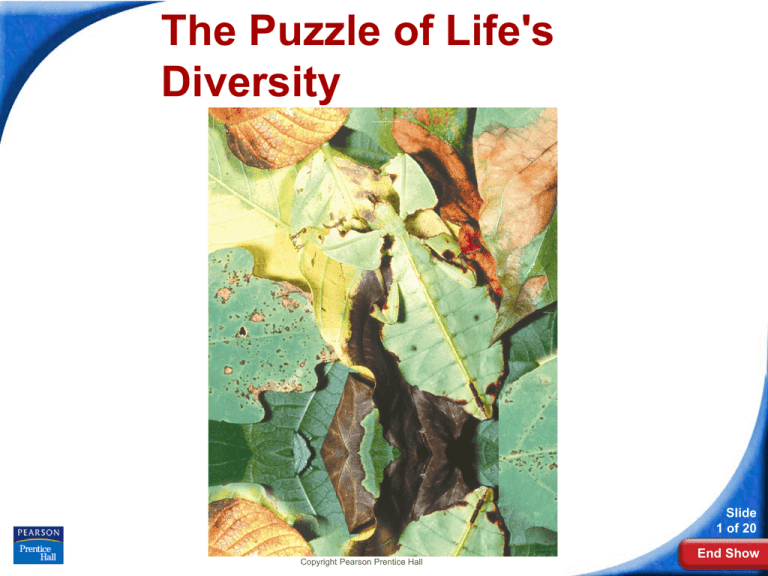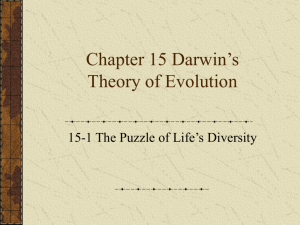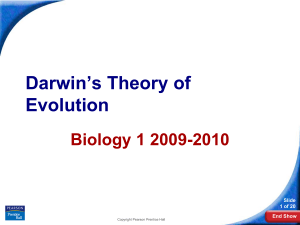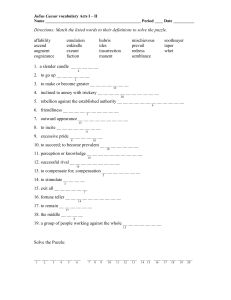
The Puzzle of Life's
Diversity
Slide
1 of 20
Copyright Pearson Prentice Hall
End Show
15-1 The Puzzle of Life's Diversity
15-1 The Puzzle of Life's Diversity
Diversity
Evolution - the process by which modern organisms
have descended from ancient organisms.
Slide
2 of 20
Copyright Pearson Prentice Hall
End Show
15-1 The Puzzle of Life's
Diversity
Voyage of the Beagle
Voyage of the Beagle
In 1831, Darwin set sail from England aboard the
H.M.S. Beagle for a voyage around the world.
Darwin went ashore and collected plant and animal
specimens for his collection.
Slide
3 of 20
Copyright Pearson Prentice Hall
End Show
15-1 The Puzzle of Life's
Diversity
Voyage of the Beagle
Slide
4 of 20
Copyright Pearson Prentice Hall
End Show
15-1 The Puzzle of Life's
Diversity
Darwin's Observations
Darwin's Observations
Organisms were well suited to the environments
they inhabited.
Slide
5 of 20
Copyright Pearson Prentice Hall
End Show
15-1 The Puzzle of Life's
Diversity
Darwin's Observations
Living Organisms and Fossils
Darwin collected fossils.
Some of those fossils resembled organisms that
were still alive.
Others looked completely unlike any creature he
had ever seen.
Slide
6 of 20
Copyright Pearson Prentice Hall
End Show
15-1 The Puzzle of Life's
Diversity
Darwin's Observations
The Galápagos Islands
Galápagos Islands were close together but had very
different climates.
Organisms varied noticeably among the different islands
Darwin wondered if animals living on different islands had
once been members of the same species.
These separate species would have evolved from an
original South American ancestor species.
Slide
7 of 20
Copyright Pearson Prentice Hall
End Show
15-1 The Puzzle of Life's
Diversity
Ideas That Shaped Darwin's
Thinking
Slide
8 of 20
Copyright Pearson Prentice Hall
End Show
15-1 The Puzzle of Life's
Diversity
An Ancient, Changing Earth
An Ancient, Changing Earth
Hutton and Lyell recognize that the Earth is
many millions of years old.
The processes that changed Earth in the past
are the same processes that operate in the
present.
Slide
9 of 20
Copyright Pearson Prentice Hall
End Show
15-1 The Puzzle of Life's
Diversity
An Ancient, Changing Earth
Darwin’s understanding of geology:
If the Earth could change over time, life might
change as well.
This would have been possible only if the Earth
were extremely old.
Slide
10 of 20
Copyright Pearson Prentice Hall
End Show
15-1 The Puzzle of Life's
Diversity
Lamarck's Evolution Hypotheses
Lamarck's Evolution Hypotheses
By selective use or disuse of organs, organisms
acquired or lost certain traits during their lifetime.
These traits could then be passed on to their
offspring.
Over time, this process led to change in a
species.
Slide
11 of 20
Copyright Pearson Prentice Hall
End Show
15-1 The Puzzle of Life's
Diversity
A male fiddler
crab uses its front
claw to ward off
predators and to
attract mates.
Lamarck's Evolution Hypotheses
Lamarck's Hypothesis
Slide
12 of 20
Copyright Pearson Prentice Hall
End Show
15-1 The Puzzle of Life's
Diversity
Because the front
claw is used
repeatedly, it
becomes larger.
Lamarck's Evolution Hypotheses
Lamarck's Hypothesis
This characteristic
(large claw) is
passed onto its
offspring.
Slide
13 of 20
Copyright Pearson Prentice Hall
End Show
15-1 The Puzzle of Life's
Diversity
Lamarck's Evolution Hypotheses
Lamarck’s hypotheses of evolution are incorrect in
several ways.
Lamarck did not know:
• how traits are inherited.
• that an organism’s behavior has no effect on
its heritable characteristics.
Slide
14 of 20
Copyright Pearson Prentice Hall
End Show
15-1 The Puzzle of Life's
Diversity
Population Growth
Population Growth
In 1798, Thomas Malthus noted that babies were
being born faster than people were dying.
The only forces that worked against this growth
were war, famine, and disease.
Slide
15 of 20
Copyright Pearson Prentice Hall
End Show
15-1 The Puzzle of Life's
Diversity
Population Growth
Malthus reasoned that if the human
population continued to grow unchecked,
sooner or later there would be insufficient
living space and food for everyone.
Slide
16 of 20
Copyright Pearson Prentice Hall
End Show
15-1 The Puzzle of Life's
Diversity
Population Growth
When Darwin read Malthus’s work, he realized
that this reasoning applied to plants and
animals.
If all the offspring of almost any species
survived for several generations, they would
overrun the world.
Slide
17 of 20
Copyright Pearson Prentice Hall
End Show
15-1 The Puzzle of Life's
Diversity
Darwin Presents His Case
Slide
18 of 20
Copyright Pearson Prentice Hall
End Show
15-1 The Puzzle of Life's
Diversity
Inherited Variation and Artificial
Selection
Inherited Variation and Artificial Selection
Members of each species vary from one another
Darwin noted that plant and animal breeders
would breed only the best organisms.
Darwin termed this process artificial selection.
Slide
19 of 20
Copyright Pearson Prentice Hall
End Show
15-1 The Puzzle of Life's
Diversity
Inherited Variation and Artificial
Selection
Cauliflower
Brussels
Sprouts
Broccoli
Kohlrabi
Ancestral
Species
Kale
Copyright Pearson Prentice Hall
Slide
20 of 20
End Show
15-1 The Puzzle of Life's
Diversity
Evolution by Natural Selection
Evolution by Natural Selection
Darwin compared processes in nature to artificial
selection.
He developed a hypothesis called Natural
Selection to explain how evolution occurs.
Slide
21 of 20
Copyright Pearson Prentice Hall
End Show
15-1 The Puzzle of Life's
Diversity
Evolution by Natural Selection
The Struggle for Existence
High birth rates vs shortages of basic needs
would force organisms to compete for food,
shelter, etc…
Slide
22 of 20
Copyright Pearson Prentice Hall
End Show
15-1 The Puzzle of Life's
Diversity
Evolution by Natural Selection
Survival of the Fittest
The ability of an individual to survive and
reproduce in its environment is fitness.
An adaptation is any inherited characteristic that
increases an organism's chance of survival.
Slide
23 of 20
Copyright Pearson Prentice Hall
End Show
15-1 The Puzzle of Life's
Diversity
Evolution by Natural Selection
Individuals with characteristics that are not well
suited to their environment either die or leave few
offspring.
Individuals that are better suited to their environment
survive and reproduce most successfully.
Darwin called this survival of the fittest.
Slide
24 of 20
Copyright Pearson Prentice Hall
End Show
15-1 The Puzzle of Life's
Diversity
Evolution by Natural Selection
Over time, natural selection results in changes
in the characteristics of a population.
These changes increase a species' fitness in its
environment.
Slide
25 of 20
Copyright Pearson Prentice Hall
End Show
15-1 The Puzzle of Life's
Diversity
Evidence of Evolution
Evidence of Evolution
Darwin argued that living things have been
evolving on Earth for millions of years.
Evidence includes:
●fossil record
●homologous structures
●similarities in embryology
Slide
26 of 20
Copyright Pearson Prentice Hall
End Show
15-1 The Puzzle of Life's
Diversity
Evidence of Evolution
Similar, But Unrelated
Species
and
and
Slide
27 of 20
Copyright Pearson Prentice Hall
End Show
15-1 The Puzzle of Life's
Diversity
Evidence of Evolution
Homologous Structures
Turtle
Alligator
Bird
Mammal
Ancient, lobefinned fish
Slide
28 of 20
Copyright Pearson Prentice Hall
End Show
15-1 The Puzzle of Life's
Diversity
Evidence of Evolution
Similarities in Embryology
The embryos of many animals with backbones are
very similar.
The same groups of embryonic cells develop in the
same order to produce the tissues of all
vertebrates.
Slide
29 of 20
Copyright Pearson Prentice Hall
End Show
15-1 The Puzzle of Life's
Diversity
Summary of Darwin's Theory
Summary of Darwin's Theory
Individual organisms differ.
Organisms produce more offspring than can
survive.
Organisms compete for limited resources.
Slide
30 of 20
Copyright Pearson Prentice Hall
End Show
15-1 The Puzzle of Life's
Diversity
Summary of Darwin's Theory
Individuals best suited to their environment survive
and reproduce.
These organisms pass their heritable traits to their
offspring.
This process of natural selection causes species to
change over time.
Slide
31 of 20
Copyright Pearson Prentice Hall
End Show
15-1 The Puzzle of Life's
Diversity
Summary of Darwin's Theory
Species alive today are descended from ancestors.
This process unites all organisms on Earth into a
single tree of life.
Slide
32 of 20
Copyright Pearson Prentice Hall
End Show







